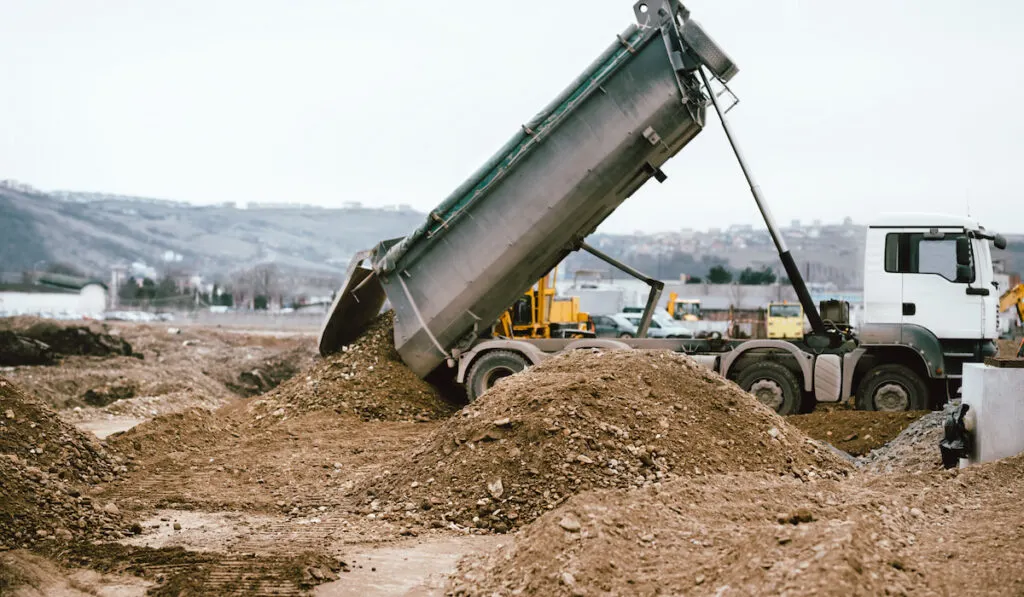*This post may have affiliate links, which means I may receive commissions if you choose to purchase through links I provide (at no extra cost to you). As an Amazon Associate, I earn from qualifying purchases. Please read my disclaimer for additional details.
Gravel is a versatile material that can be used for landscaping, paving roads and other ground cover.
There are different types of gravel where the size of stones varies, but in general, you should plan on buying around 4 cubic yards of gravel for every 100 square feet of area you want to cover in gravel that’s 12 inches deep. You’ll likely have a little leftover after that to use for filling in any gaps.

On top of paying for the stone, most gravel truckloads come with a crew of workers that charge around $50 per hour for labor. Of course, where you live and who you hire will impact how much you pay in labor costs.
You can hire temp workers for a lower wage, or you can stick with an established contractor with experience that will likely command a higher wage.
A truckload of gravel in 2021, including labor for delivery and spreading, will cost you around $1400 to start. Most companies require that you purchase at least 10 yards worth of gravel at a minimum. Depending on the project, the crew that delivers your gravel will come with a tractor to offload the rocks and spread them where you need them.
Let’s break down some of the costs associated with buying gravel and what kind of experience you can expect.
Table of Contents
Considering Different Crushed Stone Prices
The price you pay will depend on what type of gravel you need.
For example, a sharp crushed stone that’s broken down with machines will be more affordable than polished gravel with smooth edges. Larger pieces of stone will be more expensive than smaller gravel.
Sellers will present you with a range of options on sizes that each comes with their associated price. Different types of gravel include:
- Crushed Limestone
- White Gravel
- Pea Gravel
- Lava Rock
- Recycled Asphalt
- Crushed Concrete
- Crushed Marble
- Quartz Gravel
- River Rock
These are just some of the many kinds of gravel available. Quartz, marble, lava rock, and other higher-quality stone will cost you more than something like crushed concrete will. Even within each type of stone, there will be different prices based on patterns, color, and clarity.
Expect to pay anywhere from $15 to $180 per yard for gravel. That’s a wide spectrum, so you should do some research on what you need and what it will look like before you buy.
Arranging for Gravel Truckload Delivery
When you need a truckload of gravel delivered, it’s going to take a lot of work to get it spread and looking the way it should.
A lot of homeowners make the mistake of thinking unloading and spreading gravel is something that they can handle on their own.
After hours and hours of work and a sore back, they usually end up wishing they’d paid for the crew that usually comes along with the gravel.
When you order your truck of gravel, most companies are going to charge you based on how many tons you order. Delivery will run you up to $25 per ton.

What’s more, the company selling you gravel will likely have mileage restrictions on how far they’ll deliver the gravel for the flat fee.
Most of the time you’ll see companies say they’ll deliver anywhere in a 5-mile radius for free, and then start tacking on extra charges for additional miles. It’s something to consider if you’re living in a rural area where it’s going to take a while to get to you.
If you’re dealing in smaller quantities than 10 cubic yards, then it’s going to be harder to find a company willing to deliver. They’ll likely tell you that they’ll sell it to you, but you’ve got to arrange for pickup.
If you feel up to it, you can rent a truck for less than $100 a day to pick up the gravel and deliver it where it needs to go yourself.
Pricing Out Gravel
How is gravel sold? By weight? By volume? The answer to these questions is both.
A lot of places will price out your gravel per yard and ton, depending on what you are looking for. If you’re dealing with smaller amounts, you can even get a company to price gravel out per foot.
For example, a cubic foot of crushed limestone will cost you around $2.00. A ton will run you around $40, and a square yard will cost around $55.
The best gravel companies will be able to adjust quotes based on customer demand. They know that many property owners, landscaping companies, and other businesses deal in different metrics that work for them.
Some compute things in volume and others in weight. Once you have an idea of how much gravel you need, they’ll get you a quote.
Experienced gravel companies will also be able to help you gauge how much you’ll need for a specific driveway.
They’ve been doing the work for years, so most of the time they can quote you for gravel based on how long and wide your driveway is or how many flower beds you want to fill.
Spreading the Gravel

Once you’ve purchased the gravel and it’s been delivered, now the work can finally begin. Unless you’ve got the experience and enough time on your hands, we suggest hiring some help to get the job done quickly.
The company you buy from will send some workers who know what they’re doing and how to spread the gravel so it looks fantastic, has proper drainage, and is built to last.
Of course, how much help you need will depend on the project. If you’re filling in pathways in your backyard, then you may not need that much help.
With those kinds of jobs, you may not even need a truckload of gravel. You can buy smaller quantities of gravel at your local home improvement or gardening store.
People want gravel for all sorts of things like play areas for children, driveways, patio areas, landscaping features, and smaller residential roads.
Remember, if you’re installing gravel on your driveway, it’s not just a matter of putting down the crushed stone. Other materials need to go down first. They include:
Sand
You need to install about a 4-inch thick level of sand at the base of your driveway. This will help with drainage and help soak up rainwater.
Pea Gravel
Once the sand is down, then you will want to drop a 2-inch layer of pea gravel on top. This serves as a sort of filler before you put down the larger stones. It’s a good middle ground between sand and your larger paving stones when it comes to size.
Paving Stones
With the sand and the pea gravel in place, it’s time for your larger paving stones that will give your driveway the look that you want. You can use any remaining pea gravel to fill in gaps between the larger stones for a more uniform look.
Call Around
To find the best deals on a truckload of gravel, call around to different companies. Tell them about your project and ask them questions on what type of gravel they recommend, how much it will cost, and what else is involved in the project. Most companies will be eager to help you and will give you good information to make your project go more smoothly.
